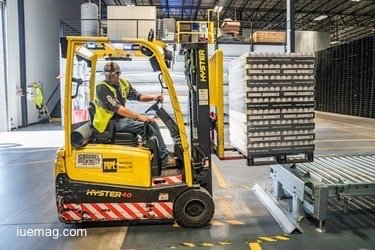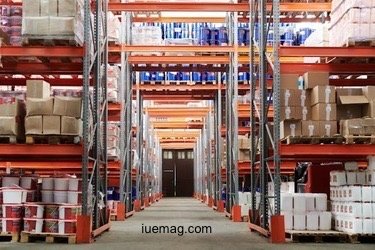

Entrepreneur's Delight
A collection of write-ups from writers/authors willing to write on Entrepreneurship, Business, Corporate Leadership & Management.

Ad
Fulfillment Fantasia: Unleashing the Power of Top-Notch Warehousing
In the labyrinth of logistics and supply chain management, the spotlight often lands on the silent yet significant player: warehousing. The efficiency of warehousing directly correlates with the seamless flow of goods from suppliers to customers, underscoring its pivotal role in modern business. Notably, facilities like storage in Kelowna epitomize the evolution of warehousing solutions, offering optimized storage and logistics services that cater to diverse needs.
 The Evolution of Warehousing
The Evolution of Warehousing
Tracing back to ancient times, warehousing initially served as simple storage points for surplus goods. However, the narrative of warehousing has dramatically shifted with the sands of time. Today, technological advancements have transformed warehouses into highly sophisticated hubs of logistics, characterized by automation and real-time inventory management. This evolution reflects the relentless pursuit of efficiency and responsiveness in meeting customer demands.
Inventory Management:
At the heart of effective warehousing lies robust inventory management, ensuring that goods are accounted for and readily available when needed. This critical component prevents overstocking or stockouts, maintaining the delicate balance of supply and demand. Modern inventory systems leverage sophisticated algorithms and real-time data to forecast demand accurately, enabling businesses to optimize their inventory levels. This not only secures product availability but also maximizes storage space efficiency, ensuring that resources are utilized to their fullest potential while safeguarding against the costly pitfalls of excess inventory or shortages.
Receiving, Storing, and Shipping:
The operational triad of receiving, storing, and shipping forms the backbone of warehousing. Each step is a cog in the larger machinery of logistics, requiring precision and efficiency to operate smoothly. This process ensures that products move through the warehouse in a timely and organized manner, minimizing bottlenecks and maximizing throughput. Effective warehousing operations are pivotal for maintaining product integrity and facilitating a seamless flow from supplier to customer. By optimizing these operations, warehouses can significantly reduce lead times and improve overall supply chain resilience.
Automation and Software Solutions:

The incorporation of technology, through automation and software solutions, has catapulted warehousing into a new era. Automated storage and retrieval systems (ASRS), warehouse management systems (WMS), and robotics are revolutionizing the way warehouses operate, enabling faster processing times and reducing human error.
These technologies not only enhance operational efficiency but also contribute to worker safety by taking over repetitive, strenuous tasks. Moreover, the integration of IoT devices and cloud-based platforms enables real-time tracking and management of inventory, providing unprecedented levels of visibility and control over warehouse operations. This technological evolution is key to accommodating the growing complexity and volume of modern supply chains.
Enhanced Efficiency and Productivity:
Top-notch warehousing facilities leverage technology and optimized processes to boost efficiency and productivity. This not only speeds up the logistics chain but also reduces operational costs. The integration of state-of-the-art warehouse management systems, automated retrieval systems, and data analytics tools ensures that resources are utilized optimally.
This holistic approach to warehousing enables businesses to achieve a streamlined workflow, significantly reducing the time goods spend in storage and thereby enhancing overall supply chain velocity. The culmination of these efforts is a leaner, more dynamic operation that can adapt to market demands with agility.
Improved Customer Satisfaction:
The ripple effect of efficient warehousing extends to the end consumer. With quicker turnaround times and accurate order fulfillment, customer satisfaction soars, fostering loyalty and repeat business. Enhanced warehousing operations ensure that products are not only delivered faster but also with a higher degree of accuracy and care, leading to fewer returns and complaints.
This heightened level of service excellence strengthens the brand's reputation in the market, making it a preferred choice for consumers. In a competitive landscape, the ability to consistently meet and exceed customer expectations is a pivotal differentiator, directly attributable to the efficacy of warehousing practices.
Cost Savings and Economic Benefits:
Efficient warehousing translates into tangible cost savings. By minimizing waste, reducing errors, and optimizing operations, businesses can enjoy significant economic benefits. Advanced inventory management techniques, such as just-in-time (JIT) inventory, help in maintaining optimal stock levels, thereby reducing holding costs.
Furthermore, the strategic use of automation reduces the likelihood of human error, leading to a decrease in costly mistakes and inefficiencies. These savings can then be redirected towards growth initiatives or passed on to customers in the form of competitive pricing. Ultimately, the financial health and competitive edge of a business are significantly bolstered by the strategic implementation of efficient warehousing solutions.
Space Management:
As businesses grow, so does the challenge of managing warehouse space efficiently. Maximizing storage capacity while ensuring easy access to goods requires strategic planning and innovative solutions. Optimal space utilization becomes imperative, necessitating the adoption of vertical storage solutions and compact shelving to accommodate expanding inventories without compromising on accessibility or efficiency.
Technology Integration:
The integration of new technologies into existing warehousing operations poses a significant challenge. Balancing the cost of adoption with the anticipated benefits requires careful consideration and planning. This delicate equilibrium demands a thorough analysis of technological needs versus financial constraints, ensuring that investments align with long-term operational goals and enhance overall performance.
Workforce Management:
In the era of automation, the role of the human workforce in warehousing is evolving. Training and development become crucial to equip staff with the skills needed to manage and interact with advanced warehousing technologies. This shift necessitates a focus on upskilling and reskilling employees, ensuring they are proficient in new technologies and can work alongside automated systems effectively.

Implementing Lean Management:
Adopting lean management principles can streamline warehousing operations, eliminating waste and enhancing efficiency. This approach emphasizes continuous improvement and value maximization, encouraging warehouses to refine processes and eliminate non-value-added activities, leading to more agile and responsive operations.
Embracing Technology and Automation:
Investing in technology and automation is a forward-looking strategy that pays dividends in operational efficiency and scalability. This commitment not only future-proofs warehousing operations but also enables facilities to handle increased volumes and complexity with greater ease, ensuring they remain competitive in a rapidly evolving market.
Continuous Training and Development of Staff:
As warehousing technologies evolve, continuous training and development of staff ensure that the workforce remains competent and adaptive to changes. This ongoing educational effort is critical in cultivating a tech-savvy workforce capable of leveraging new tools and methodologies to drive warehousing efficiency and effectiveness.
Looking ahead, the future of warehousing shines brightly with the promise of further technological advancements. From drones to the Internet of Things (IoT), the innovation potential is boundless. Moreover, sustainability will play a critical role in shaping warehousing practices, as businesses increasingly seek to minimize their environmental impact. The integration of green technologies and eco-friendly practices will not only reduce the carbon footprint of warehousing operations but also align with the growing consumer demand for sustainable supply chains.
 The Evolution of Warehousing
The Evolution of WarehousingTracing back to ancient times, warehousing initially served as simple storage points for surplus goods. However, the narrative of warehousing has dramatically shifted with the sands of time. Today, technological advancements have transformed warehouses into highly sophisticated hubs of logistics, characterized by automation and real-time inventory management. This evolution reflects the relentless pursuit of efficiency and responsiveness in meeting customer demands.
Core Components of Effective Warehousing
Inventory Management:
At the heart of effective warehousing lies robust inventory management, ensuring that goods are accounted for and readily available when needed. This critical component prevents overstocking or stockouts, maintaining the delicate balance of supply and demand. Modern inventory systems leverage sophisticated algorithms and real-time data to forecast demand accurately, enabling businesses to optimize their inventory levels. This not only secures product availability but also maximizes storage space efficiency, ensuring that resources are utilized to their fullest potential while safeguarding against the costly pitfalls of excess inventory or shortages.
Warehousing Operations:
Receiving, Storing, and Shipping:
The operational triad of receiving, storing, and shipping forms the backbone of warehousing. Each step is a cog in the larger machinery of logistics, requiring precision and efficiency to operate smoothly. This process ensures that products move through the warehouse in a timely and organized manner, minimizing bottlenecks and maximizing throughput. Effective warehousing operations are pivotal for maintaining product integrity and facilitating a seamless flow from supplier to customer. By optimizing these operations, warehouses can significantly reduce lead times and improve overall supply chain resilience.
Technology in Warehousing:
Automation and Software Solutions:

The incorporation of technology, through automation and software solutions, has catapulted warehousing into a new era. Automated storage and retrieval systems (ASRS), warehouse management systems (WMS), and robotics are revolutionizing the way warehouses operate, enabling faster processing times and reducing human error.
These technologies not only enhance operational efficiency but also contribute to worker safety by taking over repetitive, strenuous tasks. Moreover, the integration of IoT devices and cloud-based platforms enables real-time tracking and management of inventory, providing unprecedented levels of visibility and control over warehouse operations. This technological evolution is key to accommodating the growing complexity and volume of modern supply chains.
Benefits of Top-Notch Warehousing
Enhanced Efficiency and Productivity:
Top-notch warehousing facilities leverage technology and optimized processes to boost efficiency and productivity. This not only speeds up the logistics chain but also reduces operational costs. The integration of state-of-the-art warehouse management systems, automated retrieval systems, and data analytics tools ensures that resources are utilized optimally.
This holistic approach to warehousing enables businesses to achieve a streamlined workflow, significantly reducing the time goods spend in storage and thereby enhancing overall supply chain velocity. The culmination of these efforts is a leaner, more dynamic operation that can adapt to market demands with agility.
Improved Customer Satisfaction:
The ripple effect of efficient warehousing extends to the end consumer. With quicker turnaround times and accurate order fulfillment, customer satisfaction soars, fostering loyalty and repeat business. Enhanced warehousing operations ensure that products are not only delivered faster but also with a higher degree of accuracy and care, leading to fewer returns and complaints.
This heightened level of service excellence strengthens the brand's reputation in the market, making it a preferred choice for consumers. In a competitive landscape, the ability to consistently meet and exceed customer expectations is a pivotal differentiator, directly attributable to the efficacy of warehousing practices.
Cost Savings and Economic Benefits:
Efficient warehousing translates into tangible cost savings. By minimizing waste, reducing errors, and optimizing operations, businesses can enjoy significant economic benefits. Advanced inventory management techniques, such as just-in-time (JIT) inventory, help in maintaining optimal stock levels, thereby reducing holding costs.
Furthermore, the strategic use of automation reduces the likelihood of human error, leading to a decrease in costly mistakes and inefficiencies. These savings can then be redirected towards growth initiatives or passed on to customers in the form of competitive pricing. Ultimately, the financial health and competitive edge of a business are significantly bolstered by the strategic implementation of efficient warehousing solutions.
Challenges in Modern Warehousing
Space Management:
As businesses grow, so does the challenge of managing warehouse space efficiently. Maximizing storage capacity while ensuring easy access to goods requires strategic planning and innovative solutions. Optimal space utilization becomes imperative, necessitating the adoption of vertical storage solutions and compact shelving to accommodate expanding inventories without compromising on accessibility or efficiency.
Technology Integration:
The integration of new technologies into existing warehousing operations poses a significant challenge. Balancing the cost of adoption with the anticipated benefits requires careful consideration and planning. This delicate equilibrium demands a thorough analysis of technological needs versus financial constraints, ensuring that investments align with long-term operational goals and enhance overall performance.
Workforce Management:
In the era of automation, the role of the human workforce in warehousing is evolving. Training and development become crucial to equip staff with the skills needed to manage and interact with advanced warehousing technologies. This shift necessitates a focus on upskilling and reskilling employees, ensuring they are proficient in new technologies and can work alongside automated systems effectively.
Strategies for Warehousing Excellence

Implementing Lean Management:
Adopting lean management principles can streamline warehousing operations, eliminating waste and enhancing efficiency. This approach emphasizes continuous improvement and value maximization, encouraging warehouses to refine processes and eliminate non-value-added activities, leading to more agile and responsive operations.
Embracing Technology and Automation:
Investing in technology and automation is a forward-looking strategy that pays dividends in operational efficiency and scalability. This commitment not only future-proofs warehousing operations but also enables facilities to handle increased volumes and complexity with greater ease, ensuring they remain competitive in a rapidly evolving market.
Continuous Training and Development of Staff:
As warehousing technologies evolve, continuous training and development of staff ensure that the workforce remains competent and adaptive to changes. This ongoing educational effort is critical in cultivating a tech-savvy workforce capable of leveraging new tools and methodologies to drive warehousing efficiency and effectiveness.
The Future of Warehousing
Looking ahead, the future of warehousing shines brightly with the promise of further technological advancements. From drones to the Internet of Things (IoT), the innovation potential is boundless. Moreover, sustainability will play a critical role in shaping warehousing practices, as businesses increasingly seek to minimize their environmental impact. The integration of green technologies and eco-friendly practices will not only reduce the carbon footprint of warehousing operations but also align with the growing consumer demand for sustainable supply chains.
Get the Latest & Recommended articles in your Inbox
ConclusionThe journey through the realms of warehousing reveals a domain where efficiency, technology, and strategic planning converge to create a symphony of logistics excellence. As the landscape of warehousing continues to evolve, the quest for top-notch warehousing remains a critical endeavor for businesses aiming to thrive in the competitive marketplace. In this fulfillment fantasia, the power of warehousing is not just about storing goods; it's about unlocking the potential of logistics to drive business success.
Copyrights © 2024 Inspiration Unlimited eMagazine
Any facts, figures or references stated here are made by the author & don't reflect the endorsement of iU at all times unless otherwise drafted by official staff at iU. This article was first published here on 10th April 2024.



